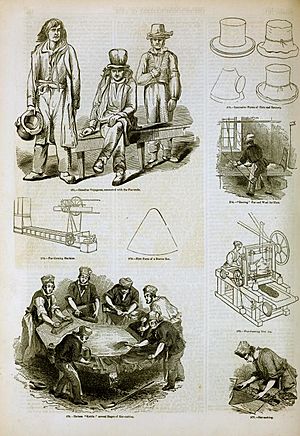Fur trade facts for kids
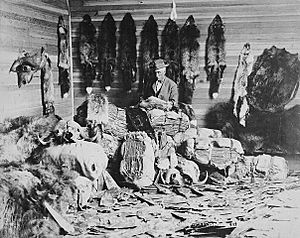
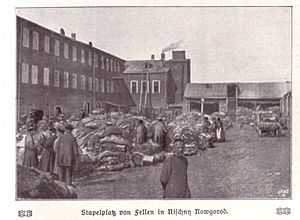
The fur trade is a worldwide industry dealing in the gain and sale of animal fur.
Before the colonization of the Americas, Russia was a major fur supplier of Western Europe and parts of Asia. The North American fur trade was a central part of the early history of contact in The New World (North America) between European-Americans and Native Americans in the United States and First Nations in Canada.
The North American fur trade flourished for 250 years. This long time can be roughly divided into three sections:
- the "French Era" from 1600 to 1760 (See Coureur de bois)
- the "British Era" from 1760 to 1816
- the "American Era" from 1816 to 1850 (See John Jacob Astor)
Contents
Russian fur trade
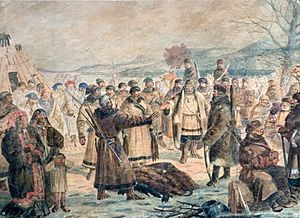
Before the colonization of the Americas, Russia was a major supplier of fur-pelts to Western Europe and parts of Asia. Fur was a major Russian export as trade developed in the Early Middle Ages ( 500-1000 AD/CE ), first through the Baltic and Black Seas. With the development of railways, Russia traded through the German city of Leipzig. In 1950 it came to an abrupt stop.
Originally, Russia exported a majority in raw furs of the pelts of martens, beavers, wolves, foxes, squirrels and hares. Between the 16th and 18th centuries, Russians tamed Siberia, a region rich in many mammal species, such as Arctic fox, lynx, sable, sea otter and stoat (ermine). In the search for the prized sea otter (pelts first used in China), and, later the northern fur seal, the Russian Empire expanded into North America, notably Alaska. Between the 17th and second half of the 19th century, Russia was the largest supplier of fur in the world. The fur trade played a vital role in the development of Siberia, the Russian Far East and the Russian colonization of the Americas. To this day sable is a regional symbol of Ural Sverdlovsk oblast and Siberian Novosibirsk, Tyumen and Irkutsk oblasts of Russia.

The European discovery of North America, with its vast forests and wildlife, particularly the beaver, led to the continent becoming a major supplier in the 17th century of fur pelts for the fur-felt hat and fur trimming and garment trades of Europe. Fur was a major source of warmth in clothing, critical prior to the organization of coal distribution. Portugal also held a big part in fur trading around the 1400s.
North American fur trade
The North American fur trade was a central part of the early history of contact between European-Americans and the native peoples of what is now the United States and Canada. In 1578 there were 350 European fishing vessels at Newfoundland. Sailors began to trade metal implements (particularly knives) for the natives' well-worn pelts. The pelts in demand were beaver, sea otter and (in the 1870s) buffalo, as well as occasionally deer, bear, ermine and skunk.
Fur robes were blankets of sewn-together, native-tanned, beaver pelts. The pelts were called castor gras in French and "coat beaver" in English, and were soon recognized by the newly developed felt-hat making industry as particularly useful for felting. Some historians, seeking to explain the term castor gras, have assumed that coat beaver was rich in human oils from having been worn so long (much of the top-hair was worn away through usage, exposing the valuable under-wool), and that this is what made it attractive to the hatters. This seems unlikely, since grease interferes with the felting of wool, rather than enhancing it. By the 1580s, beaver "wool" was the major starting material of the French felt-hatters. Hat makers began to use it in England soon after, particularly after Huguenot refugees brought their skills and tastes with them from France.
Early organization
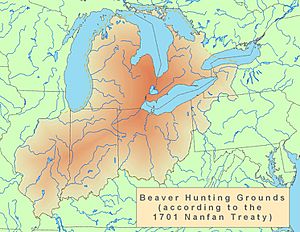
Captain Chauvin made the first organized attempt to control the fur trade in New France. In 1599 he acquired a monopoly from Henry IV and tried to establish a colony at the mouth of the Saguenay River (Tadoussac, Quebec). French explorers (and Coureur des bois—Étienne Brûlé, Samuel de Champlain, Radisson, La Salle, Le Saeur), while seeking routes through the continent, established relationships with Amerindians and continued to expand the trade of fur pelts for items considered 'common' by the Europeans. Mammal winter pelts were prized for warmth, particularly animal pelts for beaver wool-felt hats, which were an expensive status symbol in Europe. The demand for these beaver wool-felt hats was such that the beaver in Europe and European Russia had largely disappeared through exploitation.
In 1613 Dallas Carite and Adriaen Block headed expeditions to establish fur trade relationships with the Mohawks and Mohicans. By 1614 the Dutch were sending vessels to secure large economic returns from fur trading. The fur trade of New Netherland, through the port of New Amsterdam, depended largely on the trading depot at Fort Orange (now Albany), where much of the fur is believed to have originated in Canada, smuggled by entrepreneurs who wished to avoid the government-imposed monopoly there.
England was slower to enter the American fur trade than France and Holland, but as soon as English colonies were established, it was discovered that furs provided the best way for the colonists to remit value back to the mother country. Furs were being dispatched from Virginia soon after 1610, and the Plymouth Colony was sending substantial amounts of beaver to its London agents through the 1620s and 1630s. London merchants also made attempts to take over France's fur trade in the St Lawrence. Taking advantage of one of England's brief wars with France, Sir David Kirke captured Quebec in 1629, and brought the year's produce of furs back to London. Other English merchants also traded for furs in the St. Lawrence in the 1630s, but these were officially discouraged, and soon ceased as France strengthened its presence in Canada. Meanwhile, the New England fur trade expanded, not only inland, but northwards along the coast into the Bay of Fundy region. London's access to high quality furs was greatly increased with the capture of New Amsterdam, whereupon the fur trade of that colony (now called New York) fell into English hands.
The English fur trade entered a new phase in 1668. Two French citizens, Radisson and Groseilliers, had traded with great success west of Lake Superior in 1659-60, but upon their return to Canada most of their furs had been seized by the authorities. Their trading voyage had convinced them that the best fur country was far to the north and west, and could best be reached by ships sailing into Hudson Bay; and their treatment in Canada suggested that they would not find support for their scheme from France. They first went to New England, where they were able to find local support for at least two attempts to reach Hudson Bay, both unsuccessful. Their ideas had reached the ears of English authorities, however, and in 1665 Radisson and Groseilliers were persuaded to go to London. After some setbacks, a number of English investors were found to back another attempt for Hudson Bay. Two ships were sent out in 1668. One, with Radisson aboard, had to turn back, but the other, the Nonsuch, with Groseilliers, did penetrate the Bay. There, trading natives were contacted, a fine cargo of beaver skins was collected, and the expedition returned to London in October 1669. The delighted investors now sought a royal charter, which was obtained the next year. By it, the Hudson's Bay Company was established, and was granted a monopoly to trade into all the rivers that fall into Hudson Bay. From 1670 onwards, the Hudson's Bay Company sent two or three ships into the Bay every year, brought back furs (mainly beaver), and sold them, sometimes by private treaty but usually by public auction. The beaver was bought mainly for the English hat-making trade, while the fine furs went to Holland and Germany.
Meanwhile, in the English southern colonies (established around 1670), the deerskin trade was established based on the export hub of Charleston, South Carolina. Word spread amongst Native hunters that the Europeans would exchange pelts for European-manufactured goods that were highly desired in native communities. Axe heads, knives, awls, fish hooks, cloth of various type and color, woolen blankets, linen shirts, kettles, jewelry, glass beads, muskets, ammunition and powder were some of the major items exchanged on a 'per pelt' basis.
Colonial trading posts in the southern colonies also introduced many types of alcohol (especially brandy and rum) for trade. European traders flocked to the continent and made huge profits off the exchange. A metal axe head, for example, was exchanged for one beaver pelt (also called a 'beaver blanket'). The same pelt could fetch enough to buy dozens of axe heads in England, making the fur trade extremely profitable for the European nations. The iron axe heads replaced stone axe heads which the natives made by hand in a labor-intensive process, so they derived substantial benefits from the trade as well.
Socio-economic ties
Often, the political benefits of the fur trade became more important than the economic aspects. Trade was a way to forge alliances and maintain good relations between different cultures. The fur traders, men of social and financial standing, usually went to North America as young single men and used marriages as the currency of diplomatic ties, marriages and relationships between Europeans and First Nations/Native Americans became common. Traders often married or cohabited with high-ranking Indian women. Fur trappers and other workers usually had relationships with lower ranking women. Many of their children developed their own culture, now called Métis. Their descendants of mixed European and Native American parentage developed their own language and culture. They have been recognized as an ethnic group in Canada. These groups formed a two-tier society, in which descendants of fur traders and chiefs achieved prominence in social and economic circles. Lower-class descendants formed the majority of a separate Métis culture based on hunting, trapping and farming.
Because of the wealth at stake, different European-American governments competed with each other for control of the fur trade with the various native societies. Native Americans sometimes based decisions of which side to support in time of war upon which side provided them with the best trade goods in an honest manner. Because trade was so politically important, it was often heavily regulated in hopes (often futile) of preventing abuse. Unscrupulous traders sometimes cheated natives by plying them with alcohol during the transaction, which subsequently aroused resentment and often resulted in violence.
In 1834 John Jacob Astor, who had created the Pacific Fur Company, which became the largest American fur trading company, retired after recognizing that all fur-bearing animals were becoming scarce. Expanding European settlement displaced native communities from the best hunting grounds. Demand for furs subsided as European fashion trends shifted. The Native Americans' lifestyles were altered by the trade. To continue obtaining European goods on which they had become dependent and to pay off their debts, they often resorted to selling land to the European settlers. Their resentment of the forced sales contributed to future wars.
After the United States became independent, it regulated trading with Native Americans by the Indian Intercourse Act, first passed on July 22, 1790. The Bureau of Indian Affairs issued licenses to trade in the Indian Territory. In 1834 this was defined as most of the United States west of the Mississippi River, where mountain men and traders from Mexico freely operated.
Early exploration parties were often fur-trading expeditions, many of which marked the first recorded instances of Europeans' reaching particular regions of North America. For example, Abraham Wood sent fur-trading parties on exploring expeditions into the southern Appalachian Mountains, discovering the New River in the process. Simon Fraser was a fur trader who explored much of the Fraser River.
Present
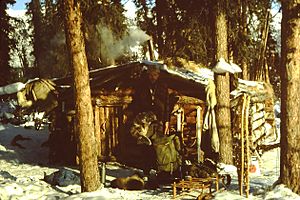
There are about 80,000 trappers in Canada (based on trapping licenses), of whom about half are Indigenous peoples.
Maritime Fur Trade
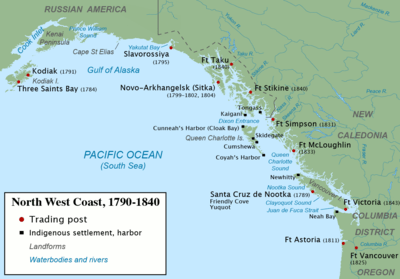
The Maritime Fur Trade was a ship-based fur trade system that focused on acquiring furs of sea otters and other animals from the indigenous peoples of the Pacific Northwest Coast and natives of Alaska. The furs were mostly sold in China in exchange for tea, silks, porcelain, and other Chinese goods, which were then sold in Europe and the United States. The maritime fur trade was pioneered by the Russians, working east from Kamchatka along the Aleutian Islands to the southern coast of Alaska. British and Americans entered during the 1780s, focusing on what is now the coast of British Columbia. The trade boomed around the turn of the 19th century. A long period of decline began in the 1810s. As the sea otter population was depleted, the maritime fur trade diversified and transformed, tapping new markets and commodities while continuing to focus on the Northwest Coast and China. It lasted until the middle to late 19th century. Russians controlled most of the coast of what is now Alaska during the entire era. The coast south of Alaska saw fierce competition between, and among, British and American trading vessels. The British were the first to operate in the southern sector, but were unable to compete against the Americans who dominated from the 1790s to the 1830s. The British Hudson's Bay Company entered the coast trade in the 1820s with the intention of driving the Americans away. This was accomplished by about 1840. In its late period the maritime fur trade was largely conducted by the British Hudson's Bay Company and the Russian-American Company.
The term "maritime fur trade" was coined by historians to distinguish the coastal, ship-based fur trade from the continental, land-based fur trade of, for example, the North West Company and American Fur Company. Historically, the maritime fur trade was not known by that name, rather it was usually called the "North West Coast trade" or "North West Trade". The term "North West" was rarely spelled as the single word "Northwest", as is common today.
The maritime fur trade brought the Pacific Northwest coast into a vast, new international trade network, centered on the north Pacific Ocean, global in scope, and based on capitalism but not, for the most part, on colonialism. A triangular trade network emerged linking the Pacific Northwest coast, China, the Hawaiian Islands (only recently discovered by the Western world), Britain, and the United States (especially New England). The trade had a major effect on the indigenous people of the Pacific Northwest coast, especially the Aleut, Tlingit, Haida, Nuu-chah-nulth, and Chinook peoples. There was a rapid increase of wealth among the Northwest Coast natives, along with increased warfare, potlatching, slaving, depopulation due to epidemic disease, and enhanced importance of totems and traditional nobility crests. The indigenous culture was not overwhelmed however but rather flourished, while simultaneously undergoing rapid change. The use of Chinook Jargon arose during the maritime fur trading era and remains a distinctive aspect of Pacific Northwest culture. Native Hawaiian society was similarly affected by the sudden influx of Western wealth and technology, as well as epidemic diseases. The trade's effect on China and Europe was minimal. For New England, the maritime fur trade and the significant profits it made helped revitalize the region, contributing to the transformation of New England from an agrarian to an industrial society. The wealth generated by the maritime fur trade was invested in industrial development, especially textile manufacturing. The New England textile industry in turn had a large effect on slavery in the United States, increasing the demand for cotton and helping make possible the rapid expansion of the cotton plantation system across the Deep South.
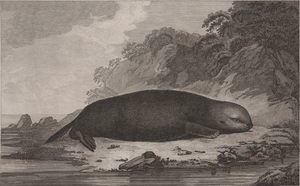
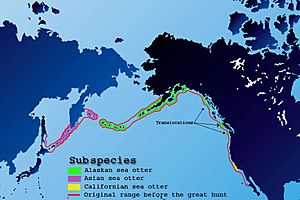
The most profitable furs were those of sea otters, especially the northern sea otter, Enhydra lutris kenyoni, which inhabited the coastal waters between the Columbia River to the south and Cook Inlet to the north. The fur of the Californian southern sea otter, E. l. nereis, was less highly prized and thus less profitable. After the northern sea otter was hunted to local extinction, maritime fur traders shifted to California until the southern sea otter was likewise nearly extinct. The British and American maritime fur traders took their furs to the Chinese port of Guangzhou (Canton), where they worked within the established Canton System. Furs from Russian America were mostly sold to China via the Mongolian trading town of Kyakhta, which had been opened to Russian trade by the 1727 Treaty of Kyakhta.
Images for kids
-
Fur trading at Fort Nez Percé in 1841
-
Sketches of life in the Hudson's Bay Company territory, 1875
-
The Russian fur traders from Alaska established their largest settlement in California, Fort Ross, in 1812
See also
 In Spanish: Comercio de pieles para niños
In Spanish: Comercio de pieles para niños


